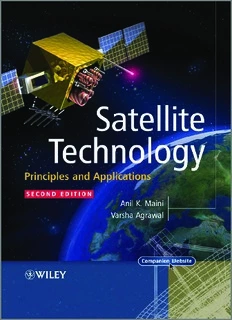
Satellite Technology: Principles and Applications, Second Edition PDF
Preview Satellite Technology: Principles and Applications, Second Edition
SATELLITE TECHNOLOGY SATELLITE TECHNOLOGY PRINCIPLES AND APPLICATIONS SecondEdition AnilK.Maini VarshaAgrawal BothofLaserScienceandTechnologyCentre, DefenceResearchandDevelopmentOrganization, MinistryofDefence,India Thiseditionfirstpublished2011 ©2011JohnWiley&SonsLtd., Registeredoffice JohnWiley&SonsLtd,TheAtrium,SouthernGate,Chichester,WestSussex,PO198SQ,UnitedKingdom Fordetailsofourglobaleditorialoffices,forcustomerservicesandforinformationabouthowtoapplyfor permission to reuse the copyright material in this book please see our website at www.wiley.com. TherightoftheauthortobeidentifiedastheauthorofthisworkhasbeenassertedinaccordancewiththeCopyright, DesignsandPatentsAct1988. Allrightsreserved.Nopartofthispublicationmaybereproduced,storedinaretrievalsystem,ortransmitted,inany formorbyanymeans,electronic,mechanical,photocopying,recordingorotherwise,exceptaspermittedbytheUK Copyright,DesignsandPatentsAct1988,withoutthepriorpermissionofthepublisher. Wileyalsopublishesitsbooksinavarietyofelectronicformats.Somecontentthatappearsinprintmaynotbe availableinelectronicbooks. Designationsusedbycompaniestodistinguishtheirproductsareoftenclaimedastrademarks.Allbrandnamesand productnamesusedinthisbookaretradenames,servicemarks,trademarksorregisteredtrademarksoftheir respectiveowners.Thepublisherisnotassociatedwithanyproductorvendormentionedinthisbook.This publicationisdesignedtoprovideaccurateandauthoritativeinformationinregardtothesubjectmattercovered.Itis soldontheunderstandingthatthepublisherisnotengagedinrenderingprofessionalservices.Ifprofessionaladvice orotherexpertassistanceisrequired,theservicesofacompetentprofessionalshouldbesought. LibraryofCongressCataloging-in-PublicationData Maini,AnilKumar. Satellitetechnology:principlesandapplications/AnilK.Maini,VarshaAgrawal.–2nded. p.cm. Includesindex. ISBN978-0-470-66024-9(cloth) 1.Artificialsatellites.I.Agrawal,Varsha.II.Title. TL796.M282010 629.43’4–dc22 2010015325 AcataloguerecordforthisbookisavailablefromtheBritishLibrary. PrintISBN:9780470660249(H/B) ePDFISBN:9780470711729 oBookISBN:9780470711736 Setin10/12TimesbyThomsonDigital,Noida,India Contents Preface xvii PARTI SATELLITETECHNOLOGY 1 IntroductiontoSatellitesandtheirApplications 3 1.1 Ever-expandingApplicationSpectrum 3 1.2 WhatisaSatellite? 4 1.3 HistoryoftheEvolutionofSatellites 7 1.3.1 EraofHotAirBalloonsandSoundingRockets 7 1.3.2 LaunchofEarlyArtificialSatellites 8 1.3.3 SatellitesforCommunications,MeteorologyandScientific Exploration–EarlyDevelopments 10 1.3.4 Non-geosynchronousCommunicationSatellites: TelstarandRelayProgrammes 11 1.3.5 EmergenceofGeosynchronousCommunication Satellites 12 1.3.6 InternationalCommunicationSatelliteSystems 15 1.3.7 DomesticCommunicationSatelliteSystems 16 1.3.8 SatellitesforotherApplicationsalsomade RapidProgress 18 1.4 EvolutionofLaunchVehicles 22 1.5 FutureTrends 28 1.5.1 CommunicationSatellites 28 1.5.2 WeatherForecastingSatellites 28 1.5.3 EarthObservationSatellites 28 1.5.4 NavigationalSatellites 29 1.5.5 MilitarySatellites 30 FurtherReading 30 Glossary 30 2 SatelliteOrbitsandTrajectories 33 2.1 DefinitionofanOrbitandaTrajectory 33 vi Contents 2.2 OrbitingSatellites–BasicPrinciples 33 2.2.1 Newton’sLawofGravitation 35 2.2.2 Newton’sSecondLawofMotion 36 2.2.3 Kepler’sLaws 37 2.3 OrbitalParameters 40 2.4 InjectionVelocityandResultingSatelliteTrajectories 57 2.5 TypesofSatelliteOrbits 63 2.5.1 OrientationoftheOrbitalPlane 63 2.5.2 EccentricityoftheOrbit 64 2.5.3 DistancefromEarth 66 2.5.4 Sun-synchronousOrbit 69 FurtherReading 72 Glossary 72 3 SatelliteLaunchandIn-orbitOperations 75 3.1 AcquiringtheDesiredOrbit 75 3.1.1 ParametersDefiningtheSatelliteOrbit 75 3.1.2 ModifyingtheOrbitalParameters 79 3.2 LaunchSequence 91 3.2.1 TypesofLaunchSequence 91 3.2.2 LaunchVehicles 96 3.3 OrbitalPerturbations 97 3.4 SatelliteStabilization 100 3.4.1 SpinStabilization 100 3.4.2 Three-axisorBodyStabilization 101 3.4.3 ComparisonbetweenSpin-stabilizedandThree-axis StabilizedSatellites 102 3.4.4 StationKeeping 103 3.5 OrbitalEffectsonSatellite’sPerformance 103 3.5.1 DopplerShift 103 3.5.2 VariationintheOrbitalDistance 103 3.5.3 SolarEclipse 104 3.5.4 SunTransitOutrage 104 3.6 Eclipses 105 3.7 LookAnglesofaSatellite 107 3.7.1 AzimuthAngle 108 3.7.2 ElevationAngle 109 3.7.3 ComputingtheSlantRange 111 3.7.4 ComputingtheLine-of-SightDistancebetweenTwoSatellites 112 3.8 EarthCoverageandGroundTracks 119 3.8.1 SatelliteAltitudeandtheEarthCoverageArea 119 3.8.2 SatelliteGroundTracks 121 3.8.3 OrbitInclinationandLatitudeCoverage 122 FurtherReading 125 Glossary 126 vii 4 SatelliteHardware 127 4.1 SatelliteSubsystems 127 4.2 MechanicalStructure 128 4.2.1 DesignConsiderations 129 4.2.2 TypicalStructure 129 4.3 PropulsionSubsystem 130 4.3.1 BasicPrinciple 131 4.3.2 TypesofPropulsionSystem 131 4.4 ThermalControlSubsystem 138 4.4.1 SourcesofThermalInequilibrium 139 4.4.2 MechanismofHeatTransfer 139 4.4.3 TypesofThermalControl 140 4.5 PowerSupplySubsystem 142 4.5.1 TypesofPowerSystem 142 4.5.2 SolarEnergyDrivenPowerSystems 143 4.5.3 Batteries 148 4.6 AttitudeandOrbitControl 152 4.6.1 AttitudeControl 153 4.6.2 OrbitControl 153 4.7 Tracking,TelemetryandCommandSubsystem 154 4.8 Payload 156 4.9 AntennaSubsystem 158 4.9.1 AntennaParameters 160 4.9.2 TypesofAntenna 163 4.10 SpaceQualificationandEquipmentReliability 177 4.10.1 SpaceQualification 177 4.10.2 Reliability 178 FurtherReading 178 Glossary 179 5 CommunicationTechniques 183 5.1 TypesofInformationSignals 183 5.1.1 VoiceSignals 184 5.1.2 DataSignals 184 5.1.3 VideoSignals 184 5.2 AmplitudeModulation 185 5.2.1 FrequencySpectrumoftheAMSignal 186 5.2.2 PowerintheAMSignal 187 5.2.3 NoiseintheAMSignal 187 5.2.4 DifferentFormsofAmplitudeModulation 189 5.3 FrequencyModulation 195 5.3.1 FrequencySpectrumoftheFMSignal 197 5.3.2 NarrowBandandWideBandFM 199 5.3.3 NoiseintheFMSignal 200 viii Contents 5.3.4 GenerationofFMSignals 204 5.3.5 DetectionofFMSignals 206 5.4 PulseCommunicationSystems 213 5.4.1 AnaloguePulseCommunicationSystems 213 5.4.2 DigitalPulseCommunicationSystems 215 5.5 SamplingTheorem 219 5.6 Shannon–HartleyTheorem 220 5.7 DigitalModulationTechniques 221 5.7.1 AmplitudeShiftKeying(ASK) 222 5.7.2 FrequencyShiftKeying(FSK) 222 5.7.3 PhaseShiftKeying(PSK) 223 5.7.4 DifferentialPhaseShiftKeying(DPSK) 224 5.7.5 QuadraturePhaseShiftKeying(QPSK) 225 5.7.6 OffsetQPSK 227 5.8 MultiplexingTechniques 228 5.8.1 FrequencyDivisionMultiplexing 228 5.8.2 TimeDivisionMultiplexing 229 FurtherReading 231 Glossary 231 6 MultipleAccessTechniques 235 6.1 IntroductiontoMultipleAccessTechniques 235 6.1.1 TransponderAssignmentModes 236 6.2 FrequencyDivisionMultipleAccess(FDMA) 237 6.2.1 DemandAssignedFDMA 239 6.2.2 Pre-assignedFDMA 239 6.2.3 CalculationofC/NRatio 239 6.3 SingleChannelPerCarrier(SCPC)Systems 242 6.3.1 SCPC/FM/FDMASystem 242 6.3.2 SCPC/PSK/FDMASystem 243 6.4 MultipleChannelsPerCarrier(MCPC)Systems 244 6.4.1 MCPC/FDM/FM/FDMASystem 244 6.4.2 MCPC/PCM-TDM/PSK/FDMASystem 245 6.5 TimeDivisionMultipleAccess(TDMA) 246 6.6 TDMAFrameStructure 246 6.6.1 ReferenceBurst 247 6.6.2 TrafficBurst 247 6.6.3 GuardTime 248 6.7 TDMABurstStructure 248 6.7.1 CarrierandClockRecoverySequence 248 6.7.2 UniqueWord 248 6.7.3 SignallingChannel 249 6.7.4 TrafficInformation 250 6.8 ComputingUniqueWordDetectionProbability 250 6.9 TDMAFrameEfficiency 251
Description: